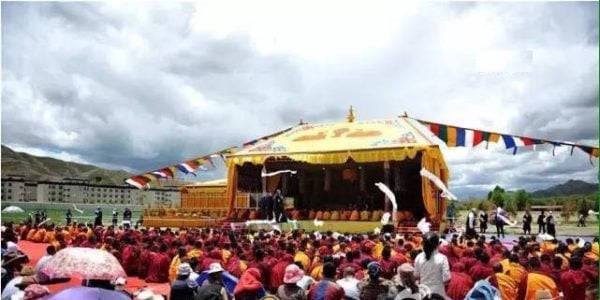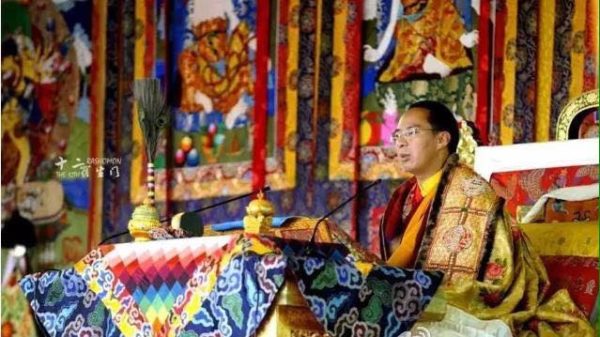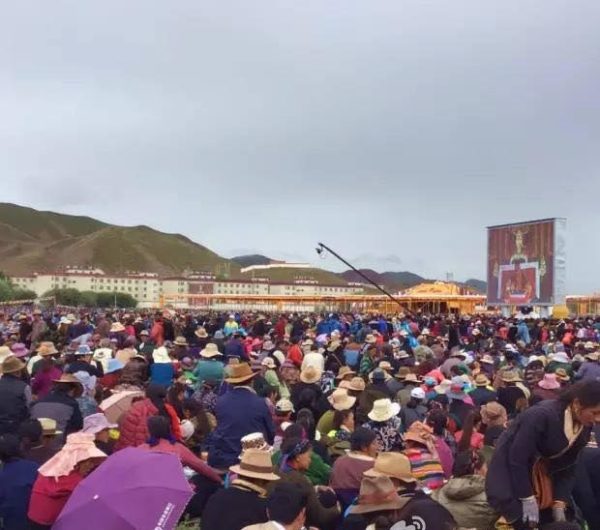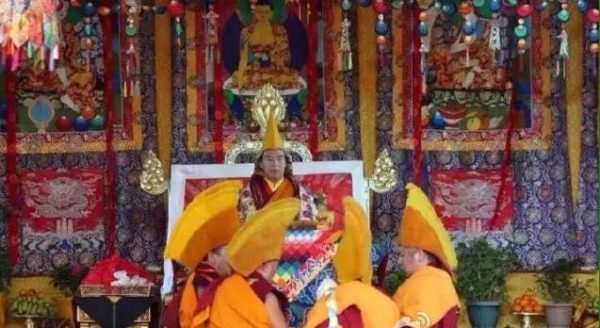
Tibetan Buddhists attend a Kalachakra initiation performed by Gyaltsen Norbu, the ‘Chinese Panchen Lama.’
- The Chinese appointed Panchen Lama, installed by the Chinese government as part of its long-term strategy to control Tibetan Buddhism and eliminate loyalty to the Dalai Lama, has carried out a major religious teaching in Shigatse – the first time a Kalachakra initiation has been held in the Tibet Autonomous Region (TAR) for more than half a century.
- The ceremony highlights the Chinese Communist Party’s efforts to raise the profile of a religious figure they appointed with political objectives, in a climate of intensifying religious oppression and a harsh campaign against the Dalai Lama, which involves preventing Tibetans from traveling into exile to attend his teachings. A major Kalachakra ceremony conferred by the Dalai Lama in exile in Ladakh in 2014 was described by the Chinese state media as “inciting hatred, terror and extremist action”, and many Tibetans returning to Tibet from a Kalachakra taught by the Dalai Lama in India in 2012 were imprisoned and ‘re-educated’ at length.
- In the same week that the Kalachakra was held in Tibet (July 21-24), news emerged of demolitions of monks’ and nuns’ homes at the globally-renowned Buddhist institute of Larung Gar in eastern Tibet, presently administered by Kardze prefecture.
- The Kalachakra ceremony in the TAR on July 21-24 was not the first to be held in Tibet since the Dalai Lama fled into exile. While repressive measures on religious practice have intensified, some major religious ceremonies including Kalachakra rituals have been permitted in Tibetan areas outside the Tibet Autonomous Region in recent years, attracting hundreds of thousands of Tibetans.
Numerous Chinese state media articles reported the attendance of more than 100,000 people every day at the ceremony conducted by the Chinese appointed Panchen Lama in Shigatse, underlining the political intention to showcase the Kalachakra as a demonstration to the outside world that Tibetans are allowed to practice their religion. The high turnout is also likely to reflect the fundamental importance of such religious teachings to the Tibetan people, who have demonstrated strong resilience and determination to protect their spiritual values and traditions despite oppression across the plateau.

Gyaltsen Norbu, installed into the position of Panchen Lama by the Chinese government, performs a Kalachakra initiation.
Gyaltsen (Gyalcain) Norbu, 25, was installed by the Chinese authorities as part of their efforts to ensure control of Tibet and assert their authority over a future incarnation of the Dalai Lama, and is compelled to conform to the role of ‘official’ Panchen Lama as a ‘patriotic’ figurehead with allegiance to the CCP. He was selected by the CCP after the boy recognized by the Dalai Lama and acknowledged by Tibetans as the authentic incarnation, Gendun Choekyi Nyima, was ‘disappeared’ in 1995. There is no indication of his whereabouts or welfare 20 years later.[1] Panchen Lamas have previously played a role in the recognition and subsequent education of Dalai Lamas, and vice versa, which is why control over the institution is considered to be so crucial by Beijing.
The Chinese state media reported that the ceremony was held at the request of monks from Tashilhunpo monastery in Shigatse, the Panchen Lama’s traditional seat, and senior Party officials were present.[2] According to one state media report: “Currently serving as vice president of the Buddhist Association of China, Panchen Lama, 26, has received some 1,000 initiations and given head-touching blessings to about 1.5 million Buddhists.”[3]
Although some of the Chinese media reports gave the impression that the ceremony was the first in Tibet in the last 50 years, in areas outside the tightly controlled TAR a number of mostly elderly lamas who are highly respected among Tibetans have held several major teachings.[4] Jamyang Gyatso, a religious teacher at Labrang Tashikyil monastery in Amdo, who is the tutor to Gyaltsen Norbu, the Chinese appointed Panchen Lama, conferred a Kalachakra initiation on June 27-30, 2015, which was attended by more than 110,000 people.[5] More than 110,000 people came from across the Tibetan plateau to attend the teachings.

Tibetan Buddhists attend a Kalachakra initiation performed by Gyaltsen Norbu, the ‘Chinese Panchen Lama.’
In Tibetan tradition, the quality of the teacher is an important measure of the pupil. While Tibetans are mostly loyal to the Dalai Lama’s recognition of Gendun Choekyi Nyima as Panchen Lama, many appreciate that Gyaltsen Norbu (known by Tibetans as Gya, or Chinese Panchen) has no choice in his role given the stringent official oversight over his activities, and they respect his teachers. Although monks are often instructed to display his photographs, there is little evidence that many adhere to this request.
Tightened controls on Tibetans attending religious teachings by the Dalai Lama
At the same time as promoting the Kalachakra by their appointed religious figure in Shigatse, the Chinese authorities have tightened controls on Tibetans attending such ceremonies when taught by the Dalai Lama in exile.
In 2014, a Kalachakra ceremony by the Dalai Lama in Ladakh, India, was described by the Chinese state media in harsher language than before, saying that it incited terror.[6] The authorities linked their attempts to prevent Tibetans from attending the Dalai Lama’s teachings in exile with ‘counter-terrorist’ work in the ‘frontline’ border areas of Tibet, including Ngari (Chinese: Ali) in the Tibet Autonomous Region, which borders India.[7] A Xinhua article published on July 7, 2014, said that the teachings, which attract thousands of Buddhists from all over the world including China, were “used by separatists for political ends”.[8] Li Decheng, head of the religious studies at the China Tibetology Research Center, was cited as saying that the “[Kalachakra] ceremony incited hatred, terror and extremist action, seriously tarnishing the Kalachakra’s nature of solemnity and purity, and affecting the healthy development of Tibetan Buddhism.”
This follows a more systematic approach in discouraging Tibetans from attending religious teachings by the Dalai Lama in exile, and penalizing those who do so. Following the Kalachakra religious empowerment by the Dalai Lama in Bodh Gaya, India, in January, 2012, many returning Tibetans were detained and compelled to undergo intensive ‘patriotic education’ sessions. Some were kept in prison or forced to do hard labor for longer periods, for instance if they were caught with photographs of the Dalai Lama or mementos of the teaching.[9]
While thousands of Tibetans from inside Tibet once travelled to attend such major teachings, at the 2014 Kalachakra in Ladakh, and winter teachings by the Dalai Lama in South India in 2015, the numbers of Tibetans from Tibet in attendance were much lower than before.
The context of the Kalachakra ceremony in Shigatse is a deteriorating environment for Tibetan Buddhism particularly since overwhelmingly peaceful protests swept across Tibet in March and April 2008. The Chinese authorities responded by intensifying an already established anti-Dalai Lama campaign, issuing sweeping regulatory measures that intrude upon Tibetan Buddhist monastic affairs and implementing aggressive “legal education” programs that pressure monks and nuns to study and accept expanded government control over their religion, monasteries, and nunneries. Officials have detained, imprisoned, or beaten to death a number of monastic leaders. A harsh new ‘rectification’ drive in one area of the Tibet Autonomous Region, Driru, last year, led to the adoption of regulations in which monasteries deemed ‘illegal’ will be torn down and Tibetans who possess images of the Dalai Lama or place traditional prayer (mani) stones will be severely punished.[10]
After monks from the ‘Great Three’ monasteries in Lhasa of Sera, Drepung and Ganden took to the streets in peaceful demonstrations in March 2008, the monastic population has been subject to intensified suppression and the strengthening of control mechanisms. Hundreds of monks have been expelled and arrested from these three monasteries and others across Tibet, leading to serious fears for their survival as religious institution.

Gyaltsen Norbu performs a Kalachakra initiation.
In what may have been an effort to present him as a credible figure when commenting on religious issues, even the Chinese appointed Panchen Lama has commented last year on the declining number of monks and nuns in Tibet, particularly in the TAR. In rare comments made to top Party leaders in March 2015, translated by ICT, he said that because of the shortage of monks in Tibet and [monastic] “quotas set too low”, there is “a danger of Buddhism existing in name only”.[11]
Monasteries in the Tibet Autonomous Region that once housed thousands of monks are now reduced to a few hundred whose main responsibility is no longer religious study but tending to the buildings and tourists. The number of monks studying at large religious encampments in Tibetan areas of Kham, such as Larung Gar (in Serthar county) serves as a visible reminder of the potential that monasteries in the Tibet Autonomous Region are not allowed to fulfill. Demolitions of the homes of monks and nuns at Larung Gar last week have now raised fears for its future survival.[12]
Just prior to the Kalachakra in Shigatse, Gyaltsen Norbu made what appears to be among his first direct references to ‘separatism’ since his installation in 1995. In May he used the term, saying that Tibet is on the “frontline of the struggle against separatism”.[13] This is standard political terminology by the CCP authorities to justify extreme measures of control over Tibet.
Footnotes:
[1] See ICT report, ‘The Communist Party as Living Buddha’, https://www.https://savetibet.org/the-communist-party-as-living-buddha/
[2] Numerous Chinese state media reports covered the ceremonies, including http://www.chinanews.com/tp/hd2011/2016/07-25/660014.shtml and http://english.cri.cn/12394/2016/07/24/4161s935432.htm
[3] Chinese state media report: http://eng.tibet.cn/news/1469497736325.shtml
[4] In June 2013, the lama Setsang Lobsang Palden gave his third Kalachakra initiation in Thangkor township in Dzoege (Chinese: Ruo’ergai) in Ngaba Tibetan and Qiang Autonomous Prefecture, Sichuan, attracting more than 300,000 devotees, including many from China. Setsang Lobsang Palden, who marked his 80th birthday this year, holds a number of official posts, including Deputy Director of the Gansu Tibetan Buddhist Institute and Committee member of the Buddhist Association of China, of which the Chinese Panchen Lama Gyaltsen Norbu is Vice President. Setsang Lobsang Palden, who was in prison for 11 years during the Cultural Revolution, then taught a Kalachakra at Tsoe monastery, in Kanlho (Chinese: Gannan Tibetan Autonomous Prefecture) in Gansu Province (the Tibetan area of Amdo) in June, 2014. Two years earlier, in 2012, Tamdin Dorje, the grandfather of an important reincarnate lama, set himself on fire and died near the same monastery.
[5] Numerous Chinese state media reports covered the ceremonies, including http://www.chinanews.com/tp/hd2011/2016/07-25/660014.shtml and http://english.cri.cn/12394/2016/07/24/4161s935432.htm
[6] ICT report, January 7, 2016, https://www.https://savetibet.org/chinas-first-counter-terror-law-and-its-implications-for-tibet/
[7] In line with their broader political objectives of undermining the influence of the Dalai Lama, the Ngari authorities stepped up border security just prior to the Kalachakra in Ladakh from July 3-14 2014. At a conference in Ngari on September 2 (2014), officials asserted the “key importance” of counter-terrorist work across Tibet but in particular in the border, ‘frontline’, areas. The article in the state media (http://www.xzali.gov.cn/tv/10314.jhtml) reported comments at the meeting by Dorjee Tseten, Vice Chairman of the TAR and He Wenhao, the deputy secretary of the Regional Party Committee Political Committee.
[8] http://english.cntv.cn/2014/07/07/ARTI1404741564258795.shtml
[9] ICT report, February 22, 2012, https://www.https://savetibet.org/lockdown-in-lhasa-at-tibetan-new-year-unprecedented-detentions-of-hundreds-of-tibetans-after-dalai-lama-teaching-in-exile/
[10] ICT report, https://savetibet.org/harsh-new-rectification-drive-in-driru-nuns-expelled-and-warning-of-destruction-of-monasteries-and-mani-walls/. Also see ICT and FIDH report, ‘Chinese Crackdown on Tibetan Buddhism’, https://www.fidh.org/IMG/pdf/en-report-tibet-4.pdf
[11] Translation of his comments and analysis: ‘The ‘danger of Buddhism existing in name only’: translation of a speech by Gyaltsen Norbu, the ‘Chinese Panchen’ by Kate Saunders, https://weblog.https://savetibet.org/tag/panchen-lama/#4 and ICT report, April 21, 2015, https://www.https://savetibet.org/china-attempts-to-legitimize-its-panchen-lama-through-a-major-speech-as-the-real-panchen-lamas-birthday-approaches/
[12] ICT report, July 25, 2016, https://www.https://savetibet.org/demolitions-begin-at-larung-gar-monastery-for-the-world-as-religious-teachers-urge-calm/
[13] May 20, 2016, http://epaper.chinatibetnews.com/xzrb/html/2016-05/20/content_695566.htm

